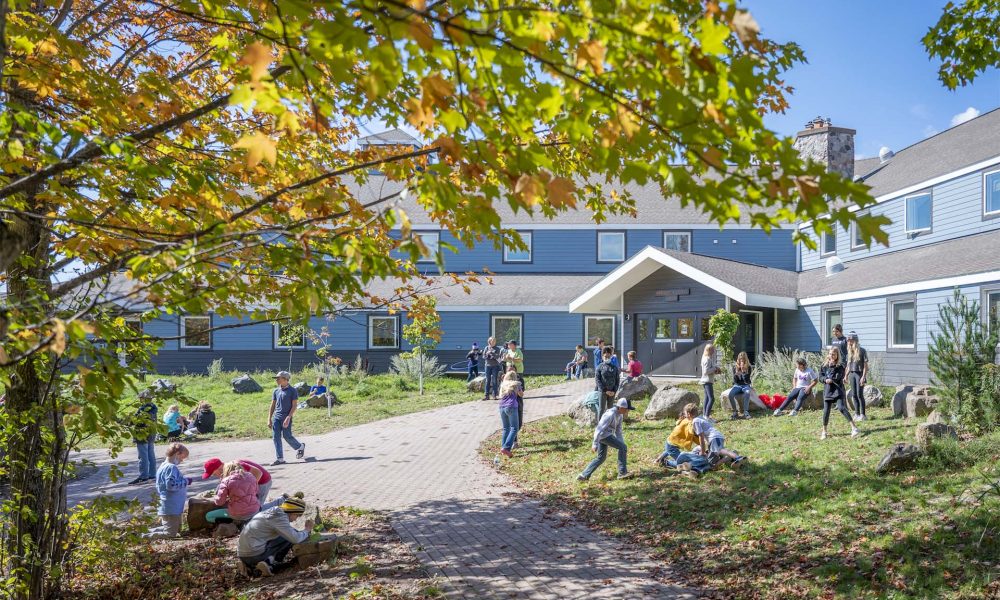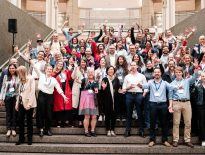The Power of Living Buildings
Environmental learning centers are often built or rebuilt as leading examples of sustainable design and construction. Mission-driven owners are well positioned to fund small buildings that achieve environmental milestones — and are inherently teaching tools. So it was no surprise that Peter Smerud, executive director of Wolf Ridge Environmental Learning Center, one of the largest residential environmental learning centers in the country (and the first accredited as a K-12 school) would want to take this kind of step as the Center upgraded its campus.
But it would be a leap to the comprehensive, holistic approach and innovations that achieve Living Building Challenge (LBC) certification. And no doubt more costly, especially in remote, forested Finland, Minnesota. Why should a nonprofit reach that far? Smerud had an inkling from early on that this work might mean that campus improvements could become transformative in a far broader way.
“Creating a Living Building is all about the people and teams,” he says. The process took years, and began with work on another campus building, as the team learned about the depth and reach of Living Building Challenge work and embarked on a training and engagement phase with contractors and tradespeople. The web of relationships and the effects of these evolving practices will continue to unfold for years to come.
We saw that reaching for LBC certification…would be an opportunity to practice our own mission. We saw a chance to sow a transformation with this project.
“The value is immense,” he says. “Donors give because they want to invest in lasting change and be part of a positive future. A Living Building embodies that. The simple fact is that we raised hundreds of thousands of dollars more because we invested in our project as a Living Building.” And the Margaret A. Cargill (MAC) Lodge, a 22,000-square-foot, 188-bed building became the first renovation project in the world to achieve full LBC certification. It was designed by HGA and constructed by Gardner Builders, and this team implemented all seven petals and all 20 imperatives.
Smerud was in a position to understand the value of building relationships. After all, that is the purpose of the Center: to build a relationship between young people and nature. And he sees how that refracts over time, when adults who spent time at the center in their youth come back and tell him about their work is informed by that experience. “That is the heart of our story,” he notes. “And we saw that reaching for LBC certification — of a renovation and in this harsh climate, too! — would be an opportunity to practice our own mission. We saw a chance to sow a transformation with this project.”
The Wolf Ridge and HGA teams conducted training workshops for all the contractors and subcontractors. “There is no limit to what you can achieve with the right team in place,” Smerud says, “and we knew that we had to build these relationships before we started this process together. It was brilliant, seeing the electricians and others chiming right in as they learned about the petals, suggesting pathways for circularity, separation of materials, and more.”
Many people think that the LBC process is incredibly difficult…but ILFI wants to help you get there…Every challenge is a dialogue…ILFI was a partner in this project, not a certifier.
Because Wolf Ridge’s primary audience is children, they decided that children would be allowed on the site every day. “Think of the power of this,” he notes. “Very soon, some of the trades saw the value of what was initially perceived as an inconvenience and unnecessary safety hazard. The kids are learning about all these trades and jobs in real time, and seeing the many hands and people involved in making a building that is part of a positive change in the world. This feature of the project came with a number of behavioral adaptations including no swearing and smoking on site and no single use plastics on site (even in their lunches!). But soon, the carpenters and insulators and their unions were all in.
“So many people think that the LBC process is incredibly difficult,” Smerud says. “But ILFI wants to help you get there. They are open to alternatives. Every challenge is a dialogue. This is the opposite of box-checking. ILFI was a partner in this project, not a certifier.
Setting aside the warm fuzzies, what about cost? This was a $9 million project. “Given that we would not now build without solar, water conservation, and local labor and lumber, it was a 10% premium for LBC certification,” Smerud says. “Donors give to people they trust who are championing something meaningful that will have lasting value. Because it was an LBC project, both foundations and individuals gave at a higher level than that at which we asked, sometimes many times over. People gave generously, because they saw the value. One donor gift exceeded the LBC premium itself.” But the value is much broader, he says. “The creation of this Living Building project touched thousands of people, and it will touch thousands of young people who stay here while they are on a journey of living and learning with nature. That value is, by any measure, immense.”
Your donation supports community impact
Do you want to be part of making lasting change? Around the world, there is a community of people working towards a living future every day. In ways great and small, they are changing minds, overcoming obstacles, and bringing ambitious projects to life. Individually, they cause ripples that show what’s possible. Collectively, they envision the regenerative future that we all want. Will you join us in this transformative work? Your donation to the International Living Future Institute equips us to assist this community with programs, technical support, events, education, and more. Your donation will help us realize the possible together.
Cover photo courtesy of Wolf Ridge.



